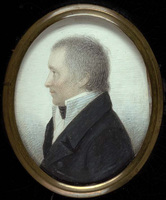 | Back to e-WV
| Back to e-WV
 The West Virginia Encyclopedia
The West Virginia Encyclopedia
 | Back to e-WV
| Back to e-WV
 The West Virginia Encyclopedia
The West Virginia Encyclopedia

The development of art in West Virginia followed similar lines to that of elsewhere in America. The earliest artistic activity was utilitarian in nature, including botanical and topographic documentation and decorative arts and crafts.
Portraiture emerged as soon as a sufficient population base existed. The Baltimore portrait artist John Drinker was active in what is now the Eastern Panhandle possibly as early as 1788 and eventually settled there. Joshua Johnson, the nation’s earliest identified professional African-American painter, and Charles Peale Polk were among many itinerant portraitists who followed Drinker’s lead in the ensuing decades. Another was Swiss immigrant David Boudon, who was in Wheeling by 1816. Other pioneer portrait artists of the Upper Ohio Valley region were painters Jarvis Hanks, John Hanna, and Charles Sullivan, and the sculptor John Airy. Hanks was among the first of his trade to visit the Kanawha Valley, where he was active by the mid- 1820s. George Esten Cooke was one of several visiting portraitists who found clients in the fashionable mineral springs region of the state.
West Virginia’s scenic beauty attracted the attention of landscape painters, including George Beck, as early as the 1790s. Harpers Ferry, in particular, became one of the most frequently painted towns in America during the early 19th century. The state’s rugged interior was explored during the ensuing decades by several notable members of the so-called Hudson River School of American landscape painters, including T. Worthington Whittredge and William L. Sonntag.
Prominent native and resident artists of the antebellum and early statehood eras included Martinsburg’s David Hunter Strother (1816–88), and Jefferson Countian David English Henderson (1832–87). Strother, also known as Porte Crayon, worked as a portrait painter during the late 1830s and 1840s before gaining employment as a writer and illustrator for Harper’s New Monthly Magazine during the early 1850s. His work in the latter capacity made him one of the best known artists in the nation by the end of the decade. A protégé of Strother, Henderson worked as an illustrator and painter of portraits and Civil War subjects.
The flood of news illustrations depicting West Virginia that appeared nationally during the Civil War likely contributed to the new wave of landscape painters who visited the state, briefly for the most part, in the decades following the war. Included in this group were Alexander Wyant, Hugh Bolton Jones, and many others whose works reflected the newer and more intimate Barbizon esthetic in landscape art. Another, with family ties to Wheeling, was Thomas P. Anshutz, a prominent figure in American art history. Anshutz’s famous painting of workers at a Wheeling nail factory, Ironworkers’ Noontime (1880), is considered a pivotal work in the development of Social Realist painting in America.
The late 19th century witnessed the birth of several West Virginia artists who achieved national prominence. William Robinson Leigh (1866–1956) of Falling Waters, Berkeley County, painted many masterful portraits and landscapes based upon West Virginia subjects before earning recognition as one of the leading artists of the Old West. A Monongalia Countian, Blanche Lazzell (1878–1956), spent her life traveling back and forth between West Virginia and Provincetown, Massachusetts, where she became a prominent printmaker and abstract painter. Piedmont native Leslie Thrasher (1889–1936) gained fame as one of the nation’s leading magazine cover illustrators, while Preston County’s William Rudolf O’Donovan (1844–1920) achieved international renown as a sculptor of bust portraits and memorials.
Like their colleagues across the nation, West Virginia artists experimented with the divergent realist and abstract currents in vogue during the early and mid-20th century. In the Northern Panhandle, Virginia B. Evans was both an Impressionist and Abstract Expressionist painter, as well as a skillful designer of art deco glass. A cousin of Blanche Lazzell, Grace Martin Taylor, explored a wide range of modernist currents in her work as an artist and as a leading teacher in the Kanawha Valley, as did Katherine Burnside in Parkersburg. Clarksburg native James Edward Davis’s progressive experiments with color and motion eventually led him to a pioneering role in the field of abstract filmmaking. These and other regional figures contributed to a flowering of artistic activity in the state during the mid-20th century which witnessed the birth of arts centers and museums across the state, many of which survive to the present.
The late 20th century brought the folk arts revival and crafts movement, featuring artists such as Jude Binder, Jeff Fetty, Wolfgang Flor, Herman Hayes, S. L. Jones, James Tyree Rexrode, Dorothy Thompson, and Connard Wolfe. Other artists from that period include painters Helen Chilton, Paula Clendenin, Charles Jupiter Hamilton, June Kilgore, Susan Poffenbarger, Chuck Ripper, Ellie Schaul, Barry Vance, and Don Whitlatch; sculptors Frank Gaylord, Bill Hopen, P. Joseph Mullins, Fred Torrey, and Gladys Tuke; and mixed-media artists such as Della Brown Taylor Hardman, David Riffle, and George Snyder.
Written by John A. Cuthbert